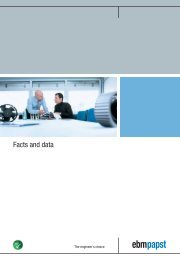Download [PDF] 2.1 MB - ebm-papst UK
Download [PDF] 2.1 MB - ebm-papst UK
Download [PDF] 2.1 MB - ebm-papst UK
Create successful ePaper yourself
Turn your PDF publications into a flip-book with our unique Google optimized e-Paper software.
for air-conditioning technology. Now there are<br />
state-of-the-art data centres that operate with<br />
a PUE (power usage effectiveness) value of approximately<br />
1.1. The PUE value describes the ratio<br />
of energy demand by the actual IT hardware and<br />
the overall energy consumption of a data centre.<br />
Thus this key figure is a measure for the efficiency<br />
of the non-IT-relevant environment, in particular,<br />
of air-conditioning technology. In the case of conventionally<br />
operated data centres, the PUE value<br />
should be about 1.9, that is, nearly half of the<br />
overall energy consumption is not used for the<br />
computing power and therefore does not serve<br />
the actual purpose of a data centre.<br />
Low energy consumption by means of free<br />
cooling The palette of cooling options for data<br />
centres is wide-ranging. This is necessary because<br />
there will be no universal solution in the<br />
future either. After all, structural conditions have<br />
just as much influence on the selection as the<br />
technology used or the climatic conditions at the<br />
location. Therefore local cooling concepts, such<br />
as a direct server cooling system in the rack, are<br />
just as appropriate as concepts for cooling entire<br />
data centre areas or even the entire building<br />
complex with a central unit. To do this, operators<br />
of data centres are increasingly relying on what is<br />
called free cooling. It operates without energy-intensive<br />
chillers and uses the data centre’s ambi-<br />
techmag 02°2013<br />
13


![Download [PDF] 2.1 MB - ebm-papst UK](https://img.yumpu.com/36174834/13/500x640/download-pdf-21-mb-ebm-papst-uk.jpg)
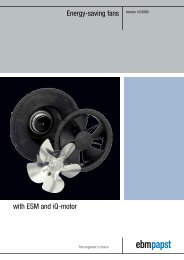
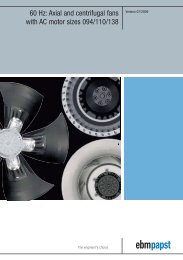
![Compact fans for AC and DC [PDF] - ebm-papst](https://img.yumpu.com/48610592/1/184x260/compact-fans-for-ac-and-dc-pdf-ebm-papst.jpg?quality=85)
![Download [PDF] 9.8 MB - ebm-papst Automotive & Drives](https://img.yumpu.com/47171334/1/184x260/download-pdf-98-mb-ebm-papst-automotive-drives.jpg?quality=85)
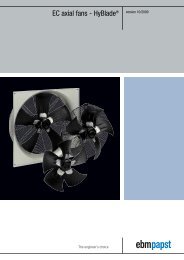
![Download [PDF] 3.1 MB - ebm-papst UK](https://img.yumpu.com/40847594/1/185x260/download-pdf-31-mb-ebm-papst-uk.jpg?quality=85)
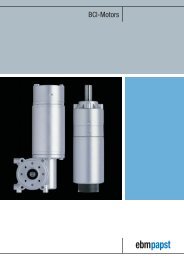
![Download [PDF] 2.3 MB - ebm-papst UK](https://img.yumpu.com/35271378/1/190x252/download-pdf-23-mb-ebm-papst-uk.jpg?quality=85)
![Download [PDF] - ebm-papst UK](https://img.yumpu.com/35139755/1/190x135/download-pdf-ebm-papst-uk.jpg?quality=85)

![Download [PDF] 1.5 MB - ebm-papst UK](https://img.yumpu.com/30021941/1/184x260/download-pdf-15-mb-ebm-papst-uk.jpg?quality=85)
![DC fans - specials [PDF] 1.2 MB](https://img.yumpu.com/28121898/1/184x260/dc-fans-specials-pdf-12-mb.jpg?quality=85)
